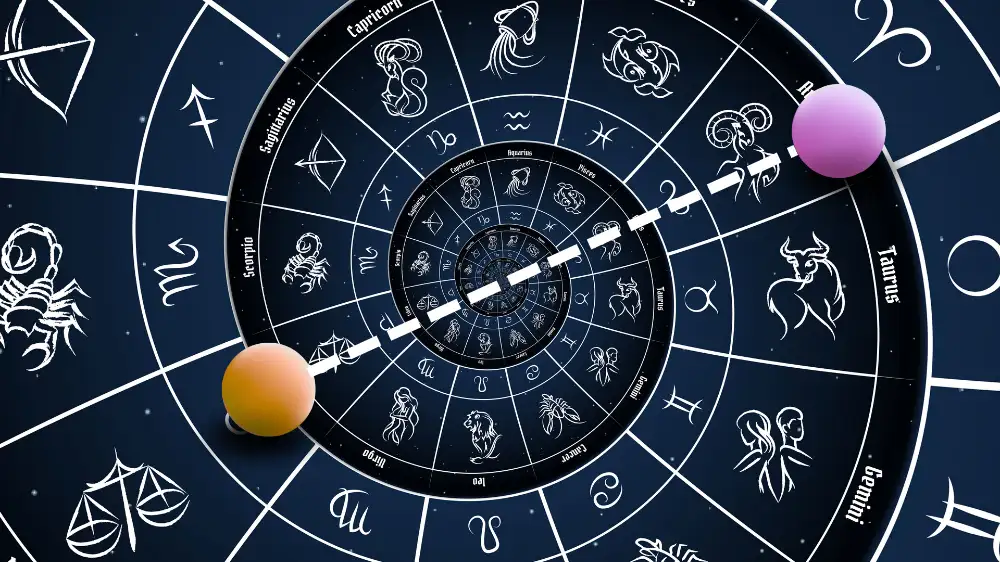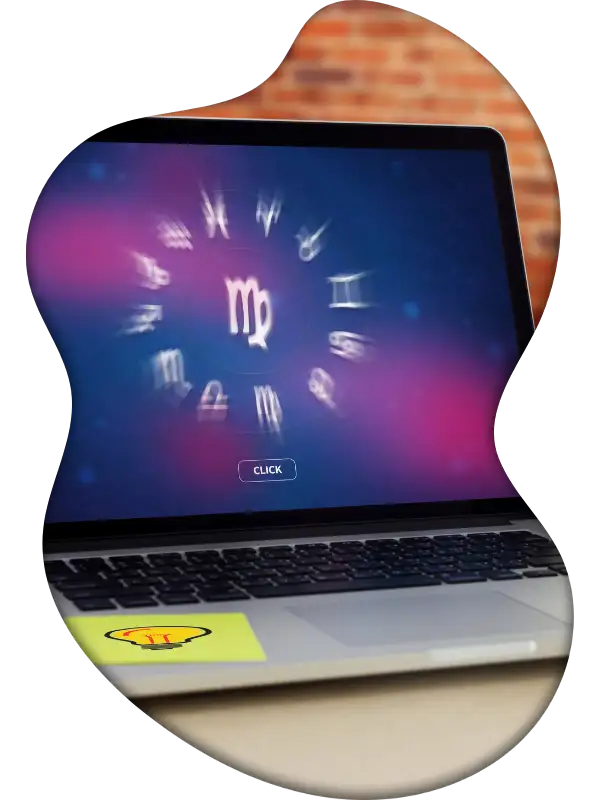Let’s imagine you have two planets in the same sign, and the faster planet is approaching the slower one. After some time, the zodiacal degrees of these two planets will coincide.
At this moment, the rays of the two planets mix. It causes a collision of two external objects, each represented by one planet.
For example, if the first planet signifies the reward the querent expects, and the second planet represents the querent, the collision of these two significators will lead to a collision of two objects—the querent and the reward.
When discussing the collision of two external objects, we always talk about an event. Here are examples of events (I will italicize the colliding objects):
- My brother is coming to visit me.
- Mom is receiving a package.
- My new book has been released and is reaching the hands of readers.
In events, we always have two significators colliding with each other.
When a planet transits through another, we call such an interaction a bodily conjunction. But there are other ways planets can come into contact with each other to mix their rays and produce events.
[toc]
Ptolemaic Aspects
We already familiar with one fascinating property of the zodiacal circle—it shares the nature of planets in places of their domiciles, exaltation, and triplicity. Everything happening to those places reflects in their rulers and vice versa.
But that’s not the only property of the zodiacal circle. It turns out that if you place a planet at any degree of the zodiac circle, it refracts the planet’s light, focusing it in 7 places:
- at a distance of ±60 degrees from the planet
- at a distance of ±90 degrees from the planet
- at a distance of ±120 degrees
- and directly opposite the planet at a distance of 180 degrees.
The zodiacal circle concentrates the rays of the planet as if it placed miniature “copies” of the planets in these specified locations.
These “copies” of the planet are called glances, or in Latin, aspects. We say that the planets cast their aspects to these places. Each glance or aspect has a name.
For example, if a planet is in 17° a,
- Its opposite “copy” is in 17° j. It is called opposition.
- It has 2 “copies” at a distance of ±120°
- to the left of the planet (against the order of the signs), in 17° l—a dexter trigon.
- to the right, in 17° g—a sinister trigon.
- Following the same principle, “copies” of the planet at a distance of ±90° are called dexter and sinister square,
- and “duplicates” of the planet at a distance of ±60° are called dexter and sinister sextile.
When a second planet passes through one of the miniature “copies” of the first one, the effect similar to a conjunction occurs—the rays of the planets mix, causing the collision of two objects.
We express it like this:
- The Moon applies to the sextile of Jupiter, or
- The Moon performs a sextile with Jupiter.
The aspect’s shape determines its name.
- Opposition, 180°, is self-evident.
- 90° is the angle between the apexes of a square shape; hence the name—square.
- 120° is the angle between the apexes of the triangle; hence the name—trine or trigon. Additionally, aspects at 120° always fall into signs of the same triplicity.
- 60° is the angle between the apexes of a hexagon (six-sided figure); hence the name—sextile from the Latin sextus (six).
These aspects are called Ptolemaic aspects.
Close Aspects and Orbs
The planet acts most apparently in the degree it occupies. The same is true for its aspects.
However, this action extends beyond that degree. You can imagine a halo, called the sphere or orb of influence, that surrounds the planet. The planet’s rays immediately color everything that falls within this sphere, and the closer to the center, the stronger the impact. The same is true for all seven “copies” of the planet. So when the significator comes closely to the body or aspect of another planet and falls within its orb, it mixes its rays with the ones of the planet.
When two significators mix their rays, we talk about the connection arising between the objects they represent. We read this in context, for instance:
- He is constantly in touch with his boss.
- His brother is tied with this organization.
- This bookmark is conjoined with the book (in the context—it lies within a book).
We call such a placement of planets a close conjunction and close aspect.
We can also read a close aspect as the influence of one planet on another. Imagine the situation: planet A is in a place of its detriment. It indicates something destructive—a dangerous organization, a dirty bookmark, etc. Its orb is full of “toxic” rays. When the second significator approaches such a planet or its aspect and enters its orb of influence, it immediately experiences adverse effects. As usual, we read this in context:
- His intense work is interfering with his relationships.
- The brother is associated with a dangerous organization.
- The dirty bookmark spoils the book.
N.B.:
We have already discussed the influence of one planet on another through reception. The difference between influence through aspect and reception is as follows:
- Reception indicates a specific influence of one object on another.
- An aspect shows the general influence of the object in connection with its good or bad condition.
Feel the difference:
- This flower causes an allergy in John (specifically), although its scent is beautiful, and most people enjoy it.
- This flower causes tearing in any person because it is poisonous by nature.
Later, we will discuss how to combine an aspect’s action with the action through reception when we talk about the cumulative effect of close aspects.
Mutual and One-Sided Aspects
Let’s consider a close conjunction. The second planet that enters the orb of the first has its own orb and can influence the first planet in return. Look at the diagram below. Planet B is in the orb of planet A, and vice versa. Such a close conjunction is called full platic or mutual conjunction.
Now imagine another example: Planet B is in the orb of planet A. But planet A is not in the planet’s B orb and doesn’t experience any counter-influence in return.
Here are examples of such one-sided manifestations:
- His demanding work is interfering with his relationship, but he cannot do anything about it.
- The dangerous organization suppresses the brother, but he has no way to resist.
We call such one-sided influence of planets a partial platic conjunction.
The same is true if a planet closely stays with another planet’s aspect. For example, Jupiter is at 17 Aries, and Venus is at 19 Sagittarius. Then we would say:
- Venus at 19° l is next to the dexter trigon of Jupiter, which is in 17° l. Venus is in the orb of Jupiter’s trine (the miniature “copy” of Jupiter), so she experiences Jupiter’s influence.
- Jupiter at 17° a is next to the sinister trigon of Venus, which is in 19° a. Jupiter is in the orb of Venus’ trine and experiences her influence.
It was an example of mutual trine. We express this as:
- Jupiter and Venus are in a close mutual trine.
- Jupiter and Venus are in a mutual aspect.
- Jupiter and Venus form a full platic aspect.
Now, suppose Venus is in 27° l. In that case:
- With its sinister trine, Venus would influence Jupiter,
- But Jupiter would no longer be able to reach Venus because she is outside his orb.
We would call this influence one-sided. We pronounce it like this:
- Venus casts her trine to Jupiter.
- Jupiter receives Venus’ aspect.
- Jupiter and Venus form a partial platic aspect.
Difference between Exact and Close Aspects
It is essential to understand that exact aspects perform instantly and then disappear. They describe momentary events on Earth—the collision of two objects.
On the other hand, close aspects show the connection or influence of two objects stretched over time. You can think of close aspects as a process.
- the process of marking a book with a dirty bookmark
- the process of how work influences personal life
- a long-term connection with an organization, and so on.
The Orbs of the Seven Planets
Imagine you’re watching the sunset. As the Sun sets below the horizon, you begin to see the first stars appearing in the sky—the bright ones, followed by the dimmer ones. At a particular moment, when the Sun is 18 degrees below the horizon, you’ll witness all the stars in the night sky.
Ancients believed it was precisely when the upper edge of the Sun’s halo (or sphere of virtue) fell behind the horizon, “freeing” the last faint stars hidden in the solar halo.
Now, imagine yourself observing a bright dot in the sky against the sunset background—that’s the evening star, Venus. It appears before all other stars.
You cannot see Venus in the rays of the sunset if it is positioned very close to the Sun. You can first spot Venus when it is at a distance of 5 degrees from the Sun. Morin associated Venus’ first appearance with the moment the Venusian orb began releasing itself from the solar halo.
Thus, one can quickly determine the radius of Venus’ orb. The Sun must pass 5 degrees away from Venus for the edges of the solar and Venusian orbs to touch. Hence, the radius of Venus’ orb is 18 - 5 = 13 degrees.
The radii (also called moieties) of orbs for other planets are determined using the same scheme:
- Sun—18°.
- Moon—12°.
- Mercury—8°.
- Venus—13°.
- Mars—6.5°.
- Jupiter—8°.
- Saturn—7°.
- First-magnitude stars—6°.
When planets touch the orbs of other planets for the first time, the influence of aspects and conjunctions is minimal. However, the closer planets get to the centers of the orbs of other planets, the stronger the impact.
in horary astrology we can confidently adhere to the rough approximation that within 3-4 degrees, any of the planets (regardless of the orb) will immediately influence another. However, remember, this is a simple approximation. For example, the Sun’s impact extends much further than Saturn’s.
In natal astrology, we consider both significant and weak influences; hence, we will precisely consider the planets’ orbs.
N.B.: Please note that some books contain errors (Coley, 1676; Lilly, 1659). The diameter of the planet’s orbs is confused with their radii. For instance, the Sun’s orb (36 degrees) is confused with its radius (18 degrees). They erroneously assign half of that radius (8.5 degrees) to the moiety (i.e. radius) of the Sun, meaning that the Sun can only influence within that distance. However, it contradicts the fact that a planet approaching the Sun closer than 17-18 degrees starts to experience the Sun’s influence, known as “being under the Sun’s beams.” Be cautious when reading old books and rely on the astronomical calculations provided by Morinus and presented above.
Graphical Representation of Aspects and Beholding Signs
We will display the planets’ positions in degrees within the current sign on a 30-degree ruler. This ruler will help you determine if there is a close aspect between the planets. For example, in the illustration below, the Moon is visually close to the Sun—the distance between them is less than 3 degrees.
The Sun is in 7 degrees of Virgo, which means its aspects are in:
- 7° Pisces (opposition)
- 7° Taurus and 7° Capricorn (trines)
- 7° Gemini and 7° Sagittarius (squares)
- 7° Cancer and 7° Scorpio (sextiles)
As you can see, the Moon in 5.5° Aquarius doesn’t fall into the signs of the Sun’s aspects, meaning the Moon cannot be within the Sun’s orb and form a close aspect with it. We interpret this as:
- The Moon doesn’t behold the Sun
- The Moon is in a non-beholding sign
- Virgo and Aquarius do not behold each other
Another aspect in the picture above, between Jupiter and Mercury, is entirely possible. The two planets are close to each other—within 3 degrees—and in beholding signs. Capricorn and Virgo belong to the earth element, meaning there is a 120-degree angle between them.
Thus, Jupiter and Mercury form a close trine.
Aspects on the Borders of Non-Beholding Signs
Take note of aspects occurring on the border of signs. For instance, the Moon is at 29° Cancer, while the aspect or bodily position of the Sun is at 1° Leo. Despite Cancer and Leo not beholding each other, the Moon still falls within the Sun’s sphere of influence.
The condition of the Sun (or its aspect) in Cancer differs from the one in Leo. Signs alter the planet’s state but do not deny the orb of influence. In other words, the Sun or its aspect at 1° Leo extends its influence over the 30th and 29th degrees of Cancer within its orb.
However, one should approach such aspects with special attention. Context is crucial here.
In horary astrology, a planet’s transition into a new sign often signifies a change in circumstances. In our example, the Moon at 29° Cancer is the Moon changing the sign. We interpret this as “when the Moon enters Leo, it will begin to experience the close influence of the Sun.”
Suppose the Sun represents a man, the Moon represents the querent, and the Moon’s transition to a new sign signifies a move to another city. In this case, we would say, “Once you move to another city, you will immediately engage in a romance with a man.” Until then, the sign border is like the distance between cities, preventing the Sun from influencing the Moon.
In most cases, sign borders will manifest in this way.
However, there may be exceptions if the context supports a different interpretation of planets on the sign borders. For example, Saturn is at 29 Cancer and moving backward toward decreasing signs (we will discuss retrograde motion later), and Mars has just entered Leo. Saturn represents the husband, and Mars represents the wife. We know that the two decided to take a break in their relationship—the husband returned to the city where he spent his childhood. The wife moved temporarily to her mother’s place.
The planetary positions perfectly reflect the context of the actual situation. The close conjunction of the Sun and Saturn across sign borders indicates that there is still a close connection between the two. However, as the planets move in opposite directions, their distance increases and the connection will break soon. These two will shortly decide to get a divorce. As you can see, we considered close conjunction on the sign borders since the context supported such a judgment. However, the cases like that are more of an exception.
In most cases, you will encounter the first scenario where the sign border prevents one planet from influencing another until current circumstances change (shown by one of the planets entering a new sign).


